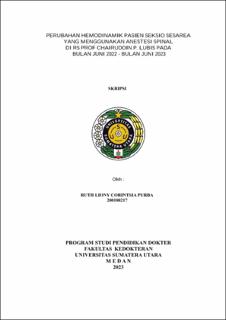| dc.contributor.advisor | Silaen, Ester Lantika Ronauli | |
| dc.contributor.author | Purba, Ruth Liony Corintsia | |
| dc.date.accessioned | 2024-02-13T03:37:37Z | |
| dc.date.available | 2024-02-13T03:37:37Z | |
| dc.date.issued | 2023 | |
| dc.identifier.uri | https://repositori.usu.ac.id/handle/123456789/91113 | |
| dc.description.abstract | Background. Cesarean section surgery is the most common hospital-based
surgery. Hypotension that occurs in patients after cesarean section is a frequent
problem associated with spinal anesthesia administration techniques with an
incidence of up to 80%, without prophylactic management. Hemodynamic changes
during the administration of spinal anesthesia for cesarean section surgery are
usually done by evaluating blood pressure, pulse, and MAP. Objective. This study
aims to compare hemodynamic changes in cesarean section surgery patients who
use spinal anesthesia techniques before being given spinal anesthesia and at some
time after being given spinal anesthesia before surgical incision for cesarean
section surgery in Prof. Chairuddin P. Lubis Hospital Medan. Methods. This
research is an experimental analytic study with experimental quasai sub design.
The sample used was taken using purposive sampling technique and estimation of
sample size using the Lemeshow formula (97 samples). Data were analyzed using
SPSS version 27 with the Wilcoxon Signed Rank test preceded by the Kolmogorov-
Smirnov normality test. Results were considered significant if the p value was
<0.05. Results. The largest frequency of patient age was in the range of 26-30 years
as many as 41 patients (42.3%). A total of 61 patients had normal Hb (62.9%). The
most common type of cesarean section surgery was elective as many as 55 patients
(56.7%). The ASA physical status of patients with the greatest frequency was II in
92 patients (94.8%). Patients had normal hemodynamic conditions both before and
after spinal anesthesia. There was a significant difference in hemodynamic
conditions before spinal anesthesia and after anesthesia before the surgical
incision of cesarean section surgery as evidenced by statistical tests that included
systolic blood pressure, diastolic blood pressure, pulse rate, and MAP with a
significance level of p<0.05. Conclusion. There are changes in blood pressure,
pulse rate, and MAP (Mean Arterial Pressure) after administration of spinal
anesthesia in cesarean section before incision from the previous state. | en_US |
| dc.language.iso | id | en_US |
| dc.publisher | Universitas Sumatera Utara | en_US |
| dc.subject | Spinal anesthesia | en_US |
| dc.subject | cesarean section | en_US |
| dc.subject | hemodynamics | en_US |
| dc.subject | mean arterial pressure | en_US |
| dc.subject | SDGs | en_US |
| dc.title | Perubahan Hemodinamik Pasien Seksio Sesarea yang Menggunakan Anestesi Spinal di RS Prof Chairuddin P. Lubis pada Bulan Juni 2022 - Bulan Juni 2023 | en_US |
| dc.type | Thesis | en_US |
| dc.identifier.nim | NIM200100217 | |
| dc.identifier.nidn | NIDN0002068308 | |
| dc.identifier.kodeprodi | KODEPRODI11201#Pendidikan Dokter | |
| dc.description.pages | 89 Halaman | en_US |
| dc.description.type | Skripsi Sarjana | en_US |


